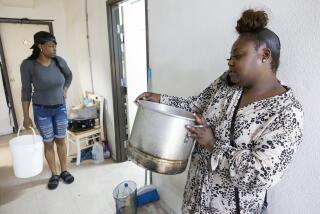L.A. Garden Shut Down; 40 Arrested
- Share via
Los Angeles County sheriff’s deputies shut down a 14-acre urban farm in South Los Angeles on Tuesday, arresting more than 40 protesters as they cleared a plot of land that has been the source of discord and controversy in the community for two decades.
The evictions occurred during a frenzied morning both at the farm and at City Hall. Mayor Antonio Villaraigosa and other city leaders continued negotiations with the landowner even as deputies used bolt cutters and power tools to remove protesters who had attached themselves to concrete-filled drums and mature trees.
In an afternoon news conference, Villaraigosa said owner Ralph Horowitz turned down $16 million -- an offer that met the asking price. Talks broke down, the mayor said, in large part because Horowitz wanted the farmers evicted.
“Today’s events are disheartening and unnecessary,” Villaraigosa said. “After years of disagreement over this property, we had all hoped for a better outcome.”
For his part, Horowitz said he had no intention of rewarding a group that included people he said had made anti-Semitic remarks about him even as they squatted rent-free on land that was costing him more than $25,000 a month to maintain -- in addition to massive legal bills fighting their efforts to remain.
“If the farmers got a donation and said, ‘We got $50 million, would you sell it to us?’ I would say no. Not a ... chance,” Horowitz said. “It’s not about the money.”
It took authorities nearly eight hours to forcibly clear protesters from the farm. Officials bulldozed vegetable gardens and chopped down an avocado tree to clear the way for a towering Fire Department ladder truck so the final four protesters could be plucked from a massive walnut tree. Among those aloft: protest organizer John Quigley and actress Daryl Hannah, who waved and smiled as supporters cheered her on from across the street.
The farm site -- and the story of how after the 1992 riots residents turned the vacant land into patches of fruits and vegetables -- has become a symbol of hope and self-sufficiency to many, attracting support from celebrities including Martin Sheen, Danny Glover and Laura Dern.
For more then a week, those camping at the site had waited for the end, running evacuation drills, attending seminars on their legal rights and orchestrating ways to impede any eviction effort.
The evictions began before the sun was even up. A warning cry went out shortly before 5 a.m. Quigley, serving as a lookout, spotted motorcycle police and a phalanx of cruisers approaching the corner of Long Beach Avenue and 41st Street and shouted from his perch.
“I heard John yell: Get up. This is real! Not a joke,” Hannah said in an interview before deputies took her from the tree.
As they had practiced, protesters took their positions -- some chained to the concrete drums, others locking arms though pre-erected pipes. Hannah scrambled to her place on a tree branch near Quigley.
In just minutes, sheriff’s deputies cut through the chain-link fence perimeter and ordered protesters out. Soon the perimeter was heavily fortified. About 250 LAPD officers secured the area, many in riot gear, as about 65 sheriff’s deputies evacuated the farm. Many streets leading into the area were blocked, snarling traffic in one of the area’s busiest commercial districts.
Seferino Hurtado, 70, an immigrant from the Mexican state of Michoacan, said he was not shocked that the farm was finally taken. He had tilled at the garden about 10 years.
“We thought it could happen one day. But I’m disappointed,” Hurtado said. “I’m older now, and when I spend time there it serves as therapy.”
The land, along an industrial corridor in an economically struggling area, has long been a source of headaches for city officials. It was seized from Horowitz in 1986 after the city used eminent domain in an effort to build an incinerator at the site. Community activists defeated that proposal, and residents turned the land into garden plots where low-income families could grow their own produce.
Horowitz, however, sued to get the land back, eventually winning. Three years ago, he paid $5 million -- close to the price he’d gotten for the land 17 years earlier -- to reacquire the parcels.
But the farmers refused to leave.
As the fight continued and got increasingly contentious, some longtime supporters were alienated and dozens of longtime farming families left their plots.
Printouts of a Spanish-language Internet site that accused Horowitz of being part of a “Jewish Mafia” controlling Los Angeles were circulated at City Hall.
Hard feelings continued at Tuesday’s protests.
Some protesters screamed obscenities at law enforcement officers in English, Spanish and even indigenous dialects. At one point, Mark Williams, whose mother, Juanita Tate, was one of the leaders of the group that blocked the incinerator project, was shouted down by farm leaders when he tried to speak to reporters.
“You let this happen! You let this happen, and now you’re blaming the sheriff. You’re a sick woman,” Williams yelled at farm organizer Rufina Juarez.
A Juarez supporter splashed water in Williams face as he spoke.
Williams said he blamed farm organizers for refusing outside help in their efforts to preserve the land.
Another battle was going on at City Hall, where a visibly annoyed Villaraigosa said a last-ditch effort to preserve the land fell apart when Horowitz said he thought it was worth an additional $2 million to $3 million. The rejected $16-million deal included a $10-million promise from the Annenberg Foundation, which sent a letter to Horowitz on June 6 affirming its intention to donate the funds.
“We met his price. He set the bar very high. Now the bar has been moved once again,” said the mayor, who supported keeping the land as a public garden.
Horowitz said his 11:30 a.m. call with the mayor -- with evacuations in full swing -- wasn’t very amicable.
He said he felt that Villaraigosa was trying to blame him for the failure to save the garden.
As far as he was concerned, Horowitz said, the departure of many families from the farm had left only “the activists, the movie stars, the anarchists and the hard-nosed group -- the ones I disliked from the beginning.”
Until recently, he said, the group had insisted that he turn over the land without compensation.
“Do you think they offered a nickel for rent? One nickel for insurance, one nickel for anything?” Horowitz asked. “No. They were demanding they be given the land for free. Fourteen years was not enough.”
Councilwoman Jan Perry, who represents the area, said Tuesday that she still favors using some of the property to create jobs -- a proposal she said reflects the desire of many area residents.
Horowitz said Tuesday that he was not sure he would sell the land. There has been talk in the past of building warehouses on part of it.
Some still held out hope that the property could be preserved as a public garden despite Tuesday’s drama. Lawyers for the farm’s leaders are due in court next month in an effort to overturn the resale of the land to Horowitz, but the argument hinges on proving that the city wasted resources in selling the property -- a difficult proposition.
Villaraigosa said the city would relocate the farmers to a 7.8-acre site at 111th Street and Avalon Boulevard that has the capacity to hold 200 garden plots.
Already, 30 farmers have been allowed to begin cultivating that land. The city has also identified 100 other plots around the city for community gardens, the mayor said.
On the garden’s outskirts, as protesters gathered for a Tuesday evening vigil, one man took a more practical tack. Jason Keehn, 45, reached through the chain links of the fence and plucked mint, chamomile and cactuses from the earth to replant at his North Hollywood home.
“It’s a symbol of the spirit of this place,” said Keehn, who arrived at the site about noon after hearing news reports of the evictions. “This is a model of what people should be doing everywhere. Why let it all get killed? Why not keep some remnants of it somewhere.”
*
Times staff writers Lynn Doan and Duke Helfand contributed to this report.
More to Read
Sign up for Essential California
The most important California stories and recommendations in your inbox every morning.
You may occasionally receive promotional content from the Los Angeles Times.












